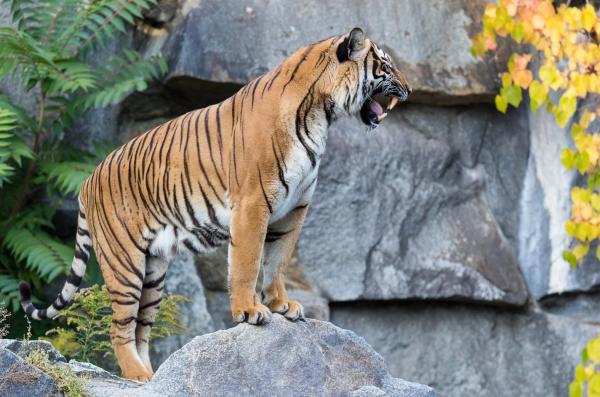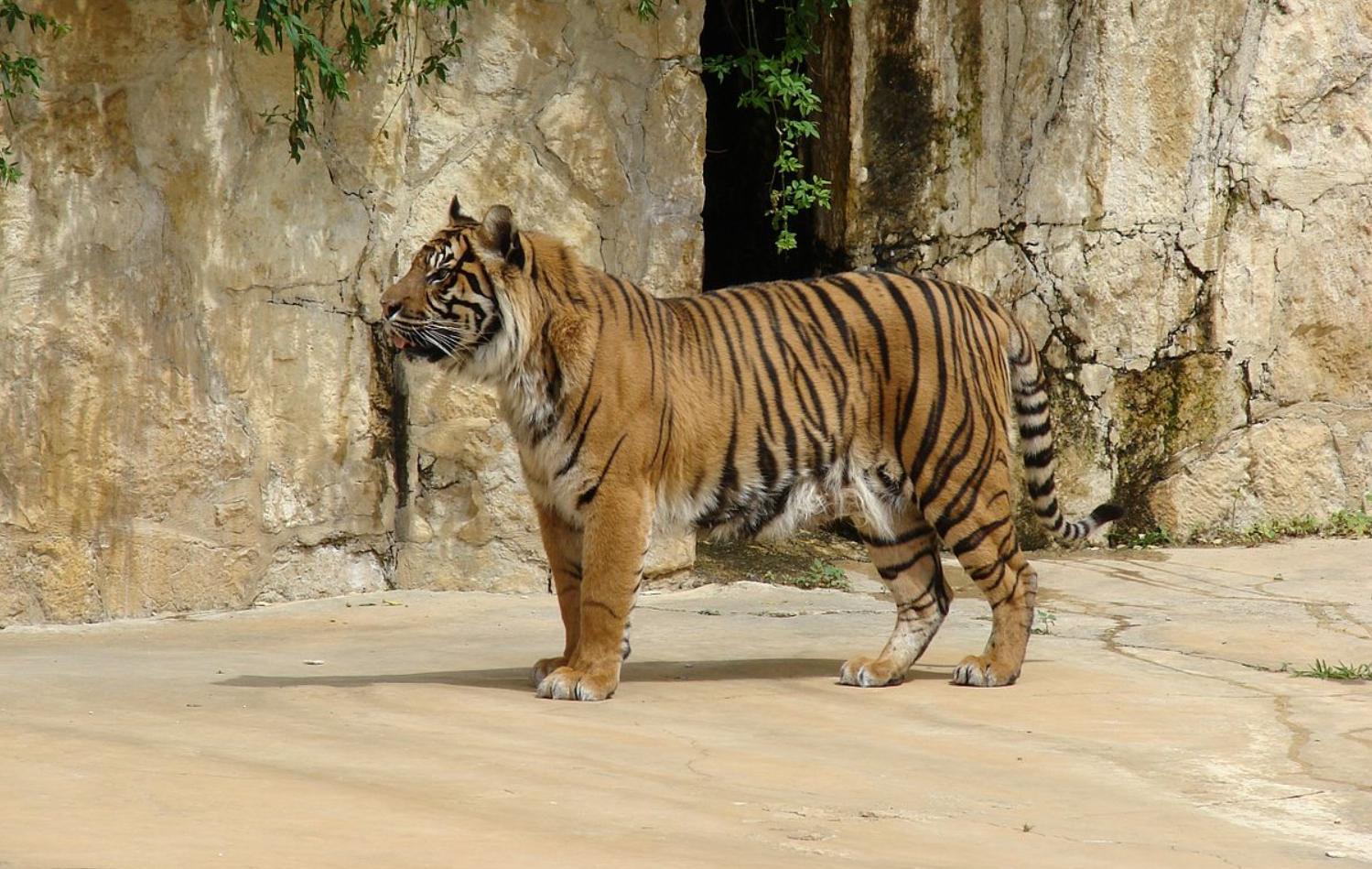Different Types of Tigers - Living and Extinct Subspecies


There is only one species of tiger (Panthera tigris), but there are different types due to the presence of subspecies which include the Bengal tiger (Panthera tigris tigris), the Indochinese tiger (Panthera tigris corbetti), the Malayan tiger (Panthera tigris jacksoni), the Sumatran tiger (Panthera tigris sumatrae), the Siberian tiger (Panthera tigris altaica) and the South China tiger (Panthera tigris amoyensis). There are also records of extinct subspecies which include the Bali tiger (Panthera tigris balica), Caspian tiger (Panthera tigris virgata) and Javan tiger (Panthera tigris sondaica).
Tigers are solitary animals found only on the Asian continent and are the largest species of the animals known as big cats, a type of wild feline. At thedailyECO, we share all the 9 different types of tigers, both living and extinct. We explain a little about each one, as well as provide photos of what they look like.
How many types of tigers are there?
As we have stated in the introduction, there are 6 extant subspecies of tiger. They are all the same species of animal which is the tiger (Panthera tigris). A subspecies is a taxonomic rank for animals that have different physical features, behaviors or habitat preferences, despite being part of the same species. The reason for this is often because they have spent a long period in terms of evolution adapting to different habitats.
The current different types of living tiger are:
- Bengal tiger (Panthera tigris tigris)
- Indochinese tiger (Panthera tigris corbetti)
- Malayan tiger (Panthera tigris jacksoni)
- Sumatran tiger (Panthera tigris sumatrae)
- Siberian tiger (Panthera tigris altaica)
- South China tiger (Panthera tigris amoyensis)
In the past there were a total of 9 subspecies. Unfortunately, 3 of them became extinct. These 3 extinct species of tiger are:
- Bali tiger (Panthera tigris balica): native to the island of Bali, Indonesia. It became extinct in the 1940s.
- Caspian tiger (Panthera tigris virgata): was found in the region around the Caspian Sea, which includes parts of Iran, Iraq, Turkey and the Caucasus. It became extinct in the 1970s.
- Javan tiger (Panthera tigris sondaica): was native to the island of Java, Indonesia. It became extinct in the 1980s.
Tigers once inhabited a wide range of countries on the Asian continent, from western Turkey to the eastern coast of Russia, as well as from the islands of Java and Bali in the south to the eastern tip of Russia. Among the main causes of the extinction of these tiger subspecies are poaching and habitat loss. Poaching has been carried out for their skins, meat and bones which have a high value on the black market, especially in traditional medicine.
Unfortunately, tigers are known for their conflicts with humans. This is because tigers are often considered a threat to livestock and the safety of people. Additionally, habitat degradation and loss due to human expansion, agriculture and deforestation have also been significant factors in the decline of their populations.
Learn more about the reasons why animals need conservation efforts with our article on the different types of environmental impact.
Bengal tiger
The Bengal tiger (Panthera tigris tigris) is a magnificent big cat known for its distinctive orange coat adorned with dark stripes as seen in the photo below. Native to the Indian subcontinent, Bengal tigers inhabit a diverse range of ecosystems, from dense mangrove swamps to tropical and subtropical forests. Recognizable by their powerful build, sharp claws, and keen senses, these apex predators are exceptional hunters, preying on various ungulates like deer and wild boar.
Bengal tigers are solitary creatures, with males being particularly territorial. Their striking appearance and enigmatic behavior have made them a symbol of strength and beauty, often featuring prominently in cultural and conservation efforts. Unfortunately, they face numerous threats, including habitat loss, human-wildlife conflict and poaching. Conservation initiatives aim to safeguard these iconic big cats and their ecosystems, highlighting the crucial role Bengal tigers play in maintaining ecological balance.

Corbett's Tiger
The Indochinese Tiger (Panthera tigris corbetti) is a subspecies of tiger native to Southeast Asia. Characterized by a distinctive appearance, these tigers typically have a rich orange-brown coat with narrow black stripes and their underparts are white. They may exhibit variations in coat color and pattern, depending on their specific habitat. Indigenous to countries like Cambodia, Laos, Myanmar, Thailand, and Vietnam, they thrive in diverse landscapes ranging from grasslands and dry forests to tropical rainforests.
Indochinese Tigers are also solitary and males generally have larger territories than females. They are powerful predators, preying on various ungulates. Unfortunately, their population faces significant threats from habitat loss, poaching and inbreeding due to small population numbers. Their current population is estimated at around 700 to 1,300 individuals. Conservation efforts are critical to preserving these magnificent creatures and their vital role in maintaining ecological balance in their native habitats.
If you want to learn about other types of animals, check out our article on the different types of flamingo species.

Malayan tiger
The Malayan tiger (Panthera tigris jacksoni) is a distinct subspecies of tiger native to the southern and central parts of the Malay Peninsula. Characterized by a shorter coat, darker coloration, and a smaller size compared to other tiger subspecies, the Malayan tiger is well-adapted to the tropical forests it inhabits. With a body length ranging from 6 to 9 feet and a weight between 52 to 195 kilograms, these tigers are agile hunters, preying on various species like deer, wild boar and smaller mammals.
Each individual Malayan tiger establishes and defends its territory fiercely. Unlike some other tiger subspecies, the Malayan tiger is well-suited to the dense vegetation of its habitat, utilizing stealth and camouflage for successful hunting. Unfortunately, this subspecies faces severe threats from habitat loss and poaching, making conservation efforts crucial for its survival.

Sumatran tiger
The Sumatran tiger (Panthera tigris sumatrae) is endemic to the island of Sumatra in Indonesia and is one of the smallest subspecies of tiger. It exhibits a dark orange to reddish-brown coat with thick black stripes. Renowned for its adaptation to dense forests, the Sumatran tiger has webbed toes for efficient swimming and a more bearded and maned appearance, particularly in males.
Recent genetic analyzes show that this subspecies has unique characteristics in its genome, which could make it a new species of tiger. Like the Malayan tiger, it has been listed as critically endangered.
Due to their ability to swim, Sumatran tigers often live in swamplands. Discover more about this type of tiger habitat with our article on the difference between lakes and swamps.

Siberian Tiger
The Siberian tiger (Panthera tigris altaica), also called the Amur or Persian tiger, is the largest felid (i.e. largest type of feline). Its range covers the evergreen and mixed forests of southeastern Russia, on the Amur River and the Russia-China border where it shares its habitat with bears, lynxes, wolves and leopards. As the photo below shows, the markings are very similar to other types of tigers.
Unlike other subspecies of tigers, they are adapted to extremely cold climates. For this reason, their fur becomes thicker than those of other tiger types. Currently its condition is critical, since its population is reduced to about 500 individuals. In 1992, a conservation program known as the Siberian Tiger Project was started, with the aim of stopping the population decline and conserving it.

South China tiger
The South China tiger (Panthera tigris amoyensis) is one of the rarest and likely the most critically endangered subspecies of tiger. Only a few individuals remain in captivity, as is the one pictured in the photo below. By harboring a series of primitive characters, it is considered the precursor of the other tiger subspecies.
Recognizable by its distinctive appearance, it has a smaller size compared to other tiger subspecies, with a slender build and shorter fur. Its coat displays a vibrant orange hue with narrow, spaced-out stripes, and it often possesses a distinctive ‘M’ shape on its forehead. Indigenous to the forests of southern China, this tiger primarily preys on deer, wild boar, and other ungulates.
Learn more about the habitats of all living and extinct tigers with our article on the different types of forests.

If you want to read similar articles to Different Types of Tigers - Living and Extinct Subspecies, we recommend you visit our Wild animals category.
- Red Lists of the International Union for Conservation of Nature. Website: https://www.iucnredlist.org/











